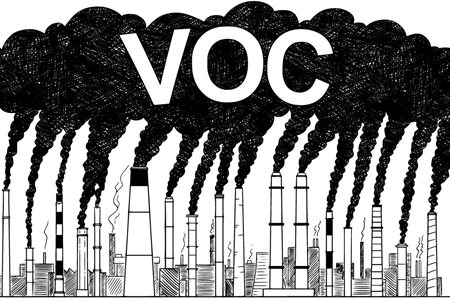Booth S11215

VOCs are on everyone's minds, these days. Ever changing regulations mean the industry must contentiously adapt. You have no doubt walked down the aisles of your local materials supplier and seen pails making all sorts of claims about how many VOCs they do or do not have. This article will briefly describe what VOCs are, how they impact the products you use, and why they are being regulated.
VOCs are volatile organic compounds. If you break that phrase down, VOCs are easy to understand. Volatile means they rapidly change state at low temperature. In the case of most common VOCs, they are liquids that evaporate rapidly at ambient temperatures. VOCs are, by definition, organic compounds, meaning they are made up of carbon linked to oxygen, hydrogen, or nitrogen. VOCs occur naturally, but many are man-made. These man-made VOCs are what regulations are most concerned with. Common man-made VOCs are benzene, xylene, and formaldehyde.
VOCs serve a wide range of purposes including as solvents and refrigerants. Some VOCs are simply by-products of other materials or chemical reactions. For concrete coatings, sealers, paints, etc, VOCs most often serve as a carrier for other materials such as acrylics or pigments. The volatile nature of VOCs allows them to dry on their own, leaving the other parts of the product in place.
VOCs are a major contributor to air pollution. Depending on the compound, they can have a wide range of effects including smog, global climate change, ozone production, and reduced air quality. VOCs can have serious health effects on humans and animals. These can include short term effects such as dizziness and fatigue, but it can also include long term organ damage, cancer, and other chronic illness.
Various state, local, and federal agencies regular the VOCs of products. The VOC level is determined by the kind of material, the kind of VOC, and local environmental needs. In most of the United States, VOCs are regulated by the EPA. Individual states or groups of states also enact their own regulations with different levels and classifications. For example, Illinois, Indiana, and Ohio all belong to the Lake Michigan Air Directors Consortium, that limits VOCs more strictly than the EPA. Some counties and local air quality districts will even set their own rules different from the EPA and state agencies. In each of these, local agencies may not allow VOCs higher than what the EPA permits. Limits on VOCs are enforceable. Dealers caught selling non v.o.c. compliant materials and contractors using them may be fined or otherwise punished.
One example of how VOCs are regulated is the South Coast Air Quality Management District. This is a governing body that controls and enforces VOC rules in a region covering Los Angeles, Orange, San Bernadino and Riverside Counties in Southern California. This board monitors and regulates air pollution from a wide range of sources including industrial emissions, automobiles, and construction products. Concrete professionals in this region would familiarize themselves with SCAQMD Rule 1113. This is the specific rule set for Architectural Coatings, which applies to most decorative concrete products. By this standard, most concrete sealer VOCs are limited to 100 grams per liter or fewer. This is in addition to the state rules issued by CARB and federal rules set by the EPA.
VOCs are important ingredients in many concrete coatings, sealers, and chemicals. However, as acceptable VOC levels trend down, contractors don't have to worry too much. Contrary to popular belief, higher VOC content products are not necessarily better. With sealer, for example, low VOC sealers will contain pretty much the same acrylics and resins as their high VOC alternatives. In either case, VOCs are designed to evaporate and leave the product as it cures, leaving equal protection of the concrete. The main difference contractors will notice is ease of application. Because there are fewer VOCs to carry the other ingredients, they will evaporate faster and the product will set sooner. Concrete contractors should adjust their application methods to suit this by spraying low VOC sealers instead of rolling or making sure to apply the sealer when conditions are cooler. In either case, these adjustments are good practice even with high VOC products and the contractor should expect equal performance of the final product.
Click here for a map of VOC regulations and the appropriate Solomon Colors/Brickform products.
Explore impressive concrete installations to find inspiration for your next project.
Find out how much color and fiber you'll need for any size project.